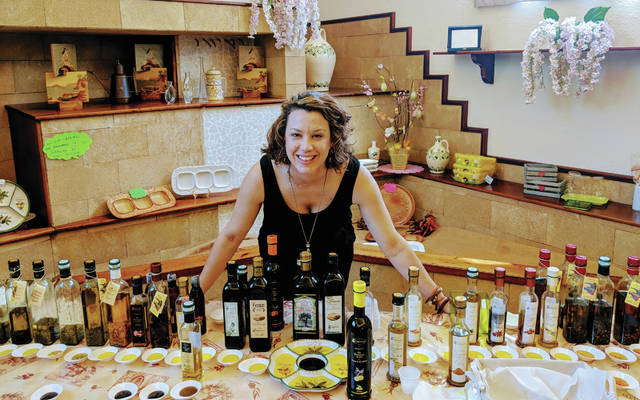Eating like an Italian takes time and practice. After my recent week in this lush country, I am ready to do the job. My only disappointment throughout the culinary adventure occurred whenever my stomach didn’t share the space my eyes needed from it.
One thing about Italians, is no food goes to waste. Not just in the kitchen, but on the table. If you take it, you eat it. An example of this was shown to me several times when I overheard servers yelling at tourists who hadn’t finished their plates. Leftover bites were taken very personally, and plates were cleaned. There’s even an Italian word for cleaning the leftover sauce in your plate with leftover bites of bread “fare la scarpetta.” It means make the little shoe. Using your hands, unless in a very formal situation, plates are cleaned of every last drop.
It’s impossible to think of Italian food without thinking about olive oil. But I’m talking next level olive oil everywhere. One of my favorite meals was at a family friend’s who made a simple salad with their family-made olive oil. They proudly boasted “extra virgin” olive oil as we all oooohhhhhh’d and ahhhhhhhh’d over the simple zest bite, served at the end of the meal. I began to notice a trend. Extra virgin olive oil seemed to be one of the common themes in Italian olive oil, separating them from most in the world.
Olive oil is considered “extra virgin” when it has been produced by a simple pressure of olives. Other grades like “olive oil” are usually produced using chemicals and other processes to extract the oil from the olives. Secondly, extra virgin must meet a certain laboratory tests in areas like acidity and levels of peroxide. And most importantly, extra virgin olive oil must taste like olives and it can’t have any negative tastes or defects.
The history of the production of olive oil dates back many years ago, even back to the times of Greek mythology. The first evidence of the production of olive oil in the Sorrentinian Peninsula, of Southern Italy, was during the age of the Greek colonies. The old Greek inhabitants produced the olive oil by grinding the olives in an old olive mill, which were made of calcareous stone. The colonies used to prepare large jars of olive oil, which were produced in Sorrento, and donate them to the Godess of Athens at Punta Campanella, and ever since then olive oil has always been a part of our tradition.
This rich history definitely required a little research. On the hills of Sorrento, in the Sorrento Peninsula, a few miles from the Amalfi Coast of Southern Italy, between the magical island of Capri and the famous active volcano, Vesuvius, you can find Frantoio Gargiulo. This beautiful olive oil factory is one of the oldest in the region dedicated to the production of extra virgin olive oil preserving the traditions of millers handed down from generation to generation.
I knew I had come to the right place when I entered the building. Greated by a large sea of students, this regional business offered a trade and vocational school to area high schoolers. After exploring the factory, the equipment, and friendly proprietors, the tasting began. Thirty-six olive oils were presented in front of my eyes, with an additional four balsamic reductions, and what ended up being two baskets of bread. Some of the oils were traditional, others were infused with truffles, or lemon, orange, fennel, cumin, garlic, the list went on. I could never have imagined so many different flavors existed.
This adventure completely changed my appreciation for area olive oils and flavors. Today I have included a few traditional Italian recipes that utilize this lush treat. If you haven’t played around with this key ingredient, now’s a great time to start.
Good luck and enjoy!
Bruschetta al Pomodora (Tomato Bruschetta)
Serves 4
12 slices crusty bread
8, medium sized, ripe tomatoes
18 basil leaves
4 garlic cloves
Sea salt
Fresh oregano
Extra virgin olive oil
Wash tomatoes, dice into small pieces. Place in bowl with a pinch of salt, 5-6 basil leaves, a clove of garlic cut in half, and sprinkle on some oregano. Allow to stand for more than 10 minutes then drizzle on as much olive oil as to your liking. Start small. Slice and toast bread. Rub a clove of garlic cut in half over the the crunchy bread. Spoon out some of the tomato mix. Garnish with a basil leaf and serve warm. Drizzle more olive oil if you like.
Fried Mozzarella
(A traditional Neopolitan dish.)
Serves 2-4
10 slices of bread
2.5 cups of fresh mozzarella
2 eggs
2 tablespoons flour
Salt to taste
Extra virgin olive oil
Remove crust from bread. Cut mozzarella into thin slices and arrange on four slices of bread. Make sure to keep the edges, then cover with the other slices of bread. Press each sandwich in your hands. Flour the edges with white flour. Use cold water to seal the edges with the flour. You can do this with your hands or dip them lightly in cold water, being careful to not get them to soggy. Put the sandwiches on a large plate, not layering on top of eachother.
Beat eggs with salt and pour mix over sandwich plate. Once bread has absorbed eggs on both sides (you may have to help with this), fry in a frying pan coated in olive oil, set on medium to high heat. Cook both sides thoroughly and place on a paper towel to absorb excess oil. Serve immediately while hot.
Olive Oil Cookies
(Light and crumbly, they are a favorite of all ages. If you can find a flavored olive oil like lemon, or orange, give that a try.)
Serves 2-4/Preheat oven to 375
2 cups white flour
1 cup sugar
2 eggs, plus one egg yolk
1 packet yeast
1 teaspoon vanilla extract
1 pinch salt
Grated lemon zest
1 cup extra virgin olive oil
1/2 tsp baking powder
Mix all ingredients, dry then wet separately, then adding together. If to wet, add a little flour. Scoop out and place on a lined, or sprayed baking sheet. Make sure cookies will not touch when baking and expanding. Bake for 15 minutes or until perfectly crisp. Add a little zest of grated lemon to the top of each cookie while cooling as a garnish. Serve immediately, or place in a sealed container and share later with a friend.
The recipes and photos used in todays article are from the kitchen of Chef Babz ([email protected]), with a little help from her friends at Frantoio Gargiulo, in Serrento, Italy (http://www.frantoiogargiulo.com).






